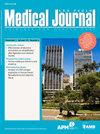Carotid artery stenting in a stroke patient with carotid web: a possibly safe treatment
IF 1.3
4区 医学
Q2 MEDICINE, GENERAL & INTERNAL
引用次数: 0
Abstract
Introduction: Carotid web (CW ) is a shelf-like luminal protrusion of the intimal layer of the carotid artery, mostly located in the posterior wall of the carotid bulb. It is a rare pathologic finding and an underrecognized cause of stroke. It can be detected on computed tomography angiography (CTA) or digital subtraction angiography (DSA) and treatment options include medically management and carotid revascularization with carotid endarterectomy (CEA) or carotid artery stenting (CAS). CEA is the therapy generally chosen by physicians. The aim is to report a patient with ischemic stroke and CW who was successfully treated with CAS. Case description: A 46-year-old female, current smoker with no comorbidities, was referred to a tertiary hospital in stroke protocol. Two months prior, she started with headache and visual blurring, evolving with reduced strength, hypoesthesia on the right side of the body and speech alteration. She was lucid and the National Institutes of Health Stroke Scale on admission was 3. She presented mild dyslalia and comprehension impairment, in addition to hypoesthesia in the right hemiface and right hand. Reflexes and muscle strength were normal on all four limbs. Her skull computed tomography demonstrated left temporoparietal hypodensity. A CTA and DSA were performed, revealing a shelf-like filling defect along the posterior wall of the bulb of the left internal carotid artery, characteristic of CW. She was treated with dual antiplatelet treatment and statin before she underwent a CAS with placement of a stent at the origin and proximal segment of the left internal carotid artery, seven days after the ictus. There were no complications and the patient was discharged two days after the procedure with the same drugs. Conclusion: Stent placement can be a safe treatment option for carotid web.颈动脉支架置入术治疗有颈动脉网的中风患者:可能安全的治疗方法
简介:颈动脉网(CW)是颈动脉内膜的一种架状管腔突出,主要位于颈动脉球后壁。这是一种罕见的病理发现,也是一种未被充分认识的中风病因。它可以通过计算机断层血管造影(CTA)或数字减影血管造影(DSA)检测到,治疗选择包括医学管理和颈动脉内膜切除术(CEA)或颈动脉支架置入术(CAS)的颈动脉重建术。CEA是医生通常选择的治疗方法。目的是报道一例缺血性脑卒中合并连续脑瘫患者,经CAS成功治疗。病例描述:一名46岁女性,目前吸烟,无合并症,被转诊至三级医院卒中方案。两个月前,她开始出现头痛、视力模糊、力量减弱、右侧身体感觉减退和语言改变。她很清醒,入院时美国国立卫生研究院中风评分为3分。除了右半脸和右手感觉减退外,她还表现出轻微的阅读障碍和理解障碍。四肢的反射和肌肉力量均正常。颅骨计算机断层显示左颞顶低密度。经CTA和DSA检查,发现沿左侧颈内动脉球囊后壁有一架状充盈缺损,为CW的特征。她接受了双重抗血小板治疗和他汀类药物治疗,然后在发作后7天,在左侧颈内动脉的起源和近段放置了支架。没有并发症,患者在手术两天后出院,使用相同的药物。结论:支架置入术是治疗颈动脉网的一种安全的方法。
本文章由计算机程序翻译,如有差异,请以英文原文为准。
求助全文
约1分钟内获得全文
求助全文
来源期刊

Sao Paulo Medical Journal
医学-医学:内科
CiteScore
2.20
自引率
7.10%
发文量
210
审稿时长
6-12 weeks
期刊介绍:
Published bimonthly by the Associação Paulista de Medicina, the journal accepts articles in the fields of clinical health science (internal medicine, gynecology and obstetrics, mental health, surgery, pediatrics and public health). Articles will be accepted in the form of original articles (clinical trials, cohort, case-control, prevalence, incidence, accuracy and cost-effectiveness studies and systematic reviews with or without meta-analysis), narrative reviews of the literature, case reports, short communications and letters to the editor. Papers with a commercial objective will not be accepted.
 求助内容:
求助内容: 应助结果提醒方式:
应助结果提醒方式:


